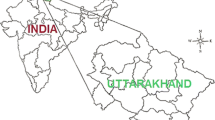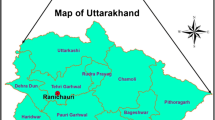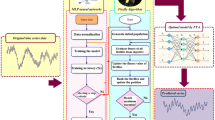Abstract
Estimation of pan evaporation (E pan) using black-box models has received a great deal of attention in developing countries where measurements of E pan are spatially and temporally limited. Multilayer perceptron (MLP) and coactive neuro-fuzzy inference system (CANFIS) models were used to predict daily E pan for a semi-arid region of Iran. Six MLP and CANFIS models comprising various combinations of daily meteorological parameters were developed. The performances of the models were tested using correlation coefficient (r), root mean square error (RMSE), mean absolute error (MAE) and percentage error of estimate (PE). It was found that the MLP6 model with the Momentum learning algorithm and the Tanh activation function, which requires all input parameters, presented the most accurate E pan predictions (r = 0.97, RMSE = 0.81 mm day−1, MAE = 0.63 mm day−1 and PE = 0.58 %). The results also showed that the most accurate E pan predictions with a CANFIS model can be achieved with the Takagi–Sugeno–Kang (TSK) fuzzy model and the Gaussian membership function. Overall performances revealed that the MLP method was better suited than CANFIS method for modeling the E pan process.




Similar content being viewed by others
References
Alecsandru CD (2003) A hybrid model-based and memory-based short-term traffic prediction system. M.Sc. thesis, Civil and Environmental Engineering, Louisiana State University and Agricultural and Mechanical College, USA
Aytek A (2009) Co-active neurofuzzy inference system for evapotranspiration modeling. Soft Comput. doi:10.1007/s00500-008-0342-8
Babuska R (1998) Fuzzy modeling for control. Springer, New York
Box GEP, Jenkins GM (1976) Time series analysis: forecasting and control. Holden Day Inc., San Francisco
Bruton JM, Mcclendon RW, Hoogenboom G (2000) Estimating daily pan evaporation with artificial neural networks. Trans ASAE 43(2):491–496
Dawson CW, Abrahart RJ, Shamseldin AY, Wilby RL (2006) Flood estimation at ungauged sites using artificial neural networks. J Hydrol 319:391–409
Eslamian SS, Gohari SA, Biabanaki M, Malekian R (2008) Estimation of monthly pan evaporation using artificial neural networks and support vector machines. J Appl Sci 8(19):3497–3502
Haciismailoglu MC, Kucuk I, Derebasi N (2009) Prediction of dynamic hysteresis loops of nano-crystalline cores. Expert Syst Appl 36:2225–2227
Keskin ME, Terzi O (2006) Artificial neural network models of daily pan evaporation. J Hydrol Eng 11(1):65–70
Keskin ME, Terzi O, Taylan D (2004) Fuzzy logic model approaches to daily pan evaporation estimation in western Turkey. Hydrol Sci J 49(6):1001–1010
Kim S, Kim HS (2008) Neural networks and genetic algorithm approach for nonlinear evaporation and evapotranspiration modeling. J Hydrol 351:299–317
Kisi O (2006) Daily pan evaporation modeling using a neuro-fuzzy computing technique. J Hydrol 329:636–646
Kisi O (2009) Modeling monthly evaporation using two different neural computing techniques. Irrig Sci 27:417–430
Kumar M, Raghuwanshi NS, Singh R, Wallender WW, Pruitt WO (2002) Estimating evapotranspiration using artificial neural network. J Irrg Drain Eng ASCE 128(4):224–233
Leahy P, Kiely G, Corcoran G (2008) Structural optimisation and input selection of an artificial neural network for river level prediction. J Hydrol 355:192–201
Lenters JD, Kratz TK, Bowser CJ (2005) Effects of climate variability on lake evaporation: results from a long-term energy budget study of Sparkling Lake, northern Wisconsin (USA). J Hydrol 308:168–195
Marofi S, Tabari H, Zare Abyaneh H (2011) Predicting spatial distribution of snow water equivalent using multivariate non-linear regression and computational intelligence methods. Water Resour Manage 25(5):1417–1435
Nayak PC, Sudheer KP, Rangan DM, Ramasastri KS (2005) Short-term flood forecasting with a neurofuzzy model. Water Resour Res 41:W04004. doi:10.1029/2004WR003562
NeuroDimension, Inc. (2005) Developers of NeuroSolutions v5.01: Neural Network Simulator. The World Wide Web address is www.nd.com, Gainesville
NeuroSolutions (2003) The neural network simulation environment. NeuroDimension Inc., USA
Penman HC (1948) Natural evaporation from open water, bare soil and grass. Proc R Soc Lond Ser A 193:120–145
Priestley CHB, Taylor RJ (1972) On the assessment of surface heat flux and evapotranspiration using large scale parameters. Mon Weather Rev 100:81–92
Rahimi Khoob A (2009) Estimating daily pan evaporation using artificial neural network in a semi-arid environment. Theor Appl Climatol 98(1–2):101–105
Rezaeian-Zadeh M, Tabari H (2012) MLP-based drought forecasting in different climatic regions. Theor Appl Climatol. doi:10.1007/s00704-012-0592-3
Roger JS, Chuen-Tsai S, Eiji M (1997) Neuro-fuzzy and soft-computing. Englewood Cliffs, Prentice Hall
Sabziparvar AA, Tabari H (2010) Comparison of artificial neural network models and non-linear regression methods for estimation of potato crop evapotranspiration in a semi-arid region of Iran. The International Conference on Intelligent Network and Computing, November 26–28, Kuala Lumpur, Malaysia
Sabziparvar AA, Tabari H, Aeini A, Ghafouri M (2010) Evaluation of class A pan coefficient models for estimation of reference crop evapotranspiration in cold-semi arid and warm arid climates. Water Resour Manage 24(5):909–920
Smrekar J, Assadi M, Fast M, Kustrin I, De S (2009) Development of artificial neural network model for a coal-fired boiler using real plant data. Energy 34:144–152
Stephens JC, Stewart EH (1963) A comparison of procedures for computing evaporation and evapotranspiration. Publication 62, International Association of Scientific Hydrology. International Union of Geodynamics and Geophysics, Berkeley, pp 123–133
Sudheer KP, Gosain AK, Rangan D, Saheb SM (2002) Modeling evaporation using an artificial neural network algorithm. Hydrol Process 16:3189–3202
Sudheer KP, Gosain AK, Ramasastri KS (2003) Estimating actual evapotranspiration from limited climate data using neural computing technique. J Irrig Drain Eng ASCE 129(3):214–218
Tabari H, Marofi S, Sabziparvar AA (2010a) Estimation of daily pan evaporation using artificial neural network and multivariate non-linear regression. Irrig Sci 28:399–406
Tabari H, Marofi S, Zare Abyaneh H, Sharifi MR (2010b) Comparison of artificial neural network and combined models in estimating spatial distribution of snow depth and snow water equivalent in Samsami basin of Iran. Neur Comput Appl 19:625–635
Tabari H, Sabziparvar AA, Ahmadi M (2011) Comparison of artificial neural network and multivariate linear regression methods for estimation of daily soil temperature in an arid region. Meteor Atmos Phys 110:135–142
Terzi O, Keskin ME (2005) Modelling of daily pan evaporation. J Appl Sci 5(2):368–372
Torres M, Hervas C, Amador F (2005) Approximating the sheep milk production curve through the use of artificial neural networks and genetic algorithms. Comput Oper Res 32:2653–2670
Trajkovic S, Todorovic B, Stankovic M (2003) Forecasting of reference evapotranspiration by artificial neural network. J Irrg Drain Eng ASCE 129(6):454–457
Vining KC (2003) Estimation of monthly evaporation from Lake Ashtabulain North Dakota, Orwell Lake in Minnesota, and LakeTraverse in Minnesota and South Dakota, 1931–2001. Water-Resources Investigations Report, US Department of the Interior, US Geological Survey
Yen J, Wang L (1999) Constructing optimal fuzzy models using statistical information criteria. J Intell Fuzzy Syst 7:185–201
Acknowledgments
The authors wish to express their gratitude to the Islamic Republic of Iran Meteorological Organization (IRIMO) for access to the weather station data. We are also grateful to the Editor and two anonymous reviewers for their helpful comments.
Author information
Authors and Affiliations
Corresponding author
Additional information
Responsible editor: L. Gimeno.
Rights and permissions
About this article
Cite this article
Tabari, H., Hosseinzadeh Talaee, P. & Abghari, H. Utility of coactive neuro-fuzzy inference system for pan evaporation modeling in comparison with multilayer perceptron. Meteorol Atmos Phys 116, 147–154 (2012). https://doi.org/10.1007/s00703-012-0184-x
Received:
Accepted:
Published:
Issue Date:
DOI: https://doi.org/10.1007/s00703-012-0184-x




